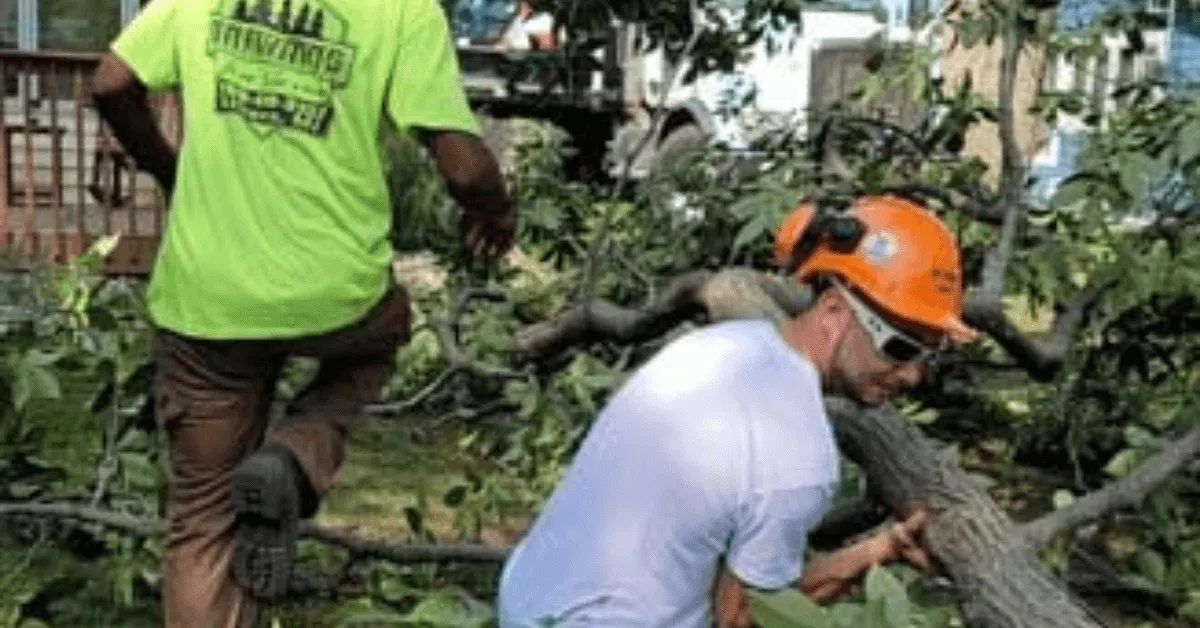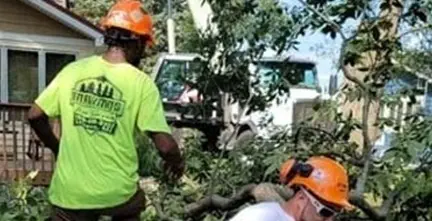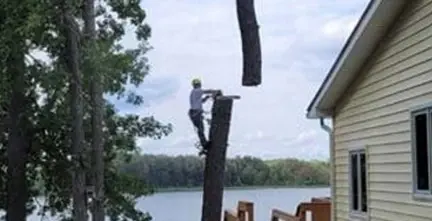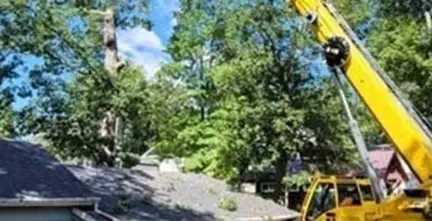Storms in Battle Creek are no longer rare, isolated events. Homeowners are seeing stronger winds, heavier rains, and more frequent storm systems than ever before. Each season brings the same worry: fallen branches, uprooted trees, blocked driveways, and damage to homes.
Waiting until after a storm to deal with tree issues can be costly – and sometimes dangerous. The most effective way to keep your property safe is to prepare your trees before the storm season begins. A proactive approach saves money on emergency removals, keeps your family safe, and helps preserve Battle Creek’s beautiful tree canopy.
Why Storm Preparation Matters
Healthy, well-maintained trees are far less likely to fail during storms. When trees are properly pruned, supported, and growing in good soil, they can better withstand strong winds and saturated ground.
Beyond property protection, storm-prepped trees also:
- Keep neighborhoods shaded and cooler during summer
- Prevent soil erosion and flooding by absorbing stormwater
- Maintain curb appeal and property values
Without preparation, storms can have a cascading effect. A broken limb can tear bark, letting in fungi and pests that slowly weaken the tree. A leaning trunk can become unstable after repeated storms, requiring removal later. Acting early prevents these issues before they turn into expensive problems.
Step 1: Get a Pre-Storm Tree Inspection
A professional inspection is the first and most important step. Certified arborists look for issues the untrained eye might miss, such as:
- Cracks in main branches or at branch unions
- Root heaving or loosened soil indicating instability
- Decay pockets hidden inside the trunk
- Overextended branches that catch too much wind
Scheduling inspections once a year – ideally before spring or summer storm season – allows you to address risks in time. Arborists can also prioritize which trees to treat, prune, or monitor closely, so you don’t waste time and money on unnecessary work.
Step 2: Prune for Strength and Safety
Trimming or Pruning is one of the most effective ways to reduce storm damage risk. Proper pruning:
- Removes dead, diseased, or broken limbs before they fall
- Shapes the tree so wind flows through the canopy rather than pushing against it
- Helps young trees develop strong, balanced structure
Be careful not to over-prune. Topping or removing too much foliage can stress the tree and create weak regrowth that is even more likely to snap in future storms. Professional arborists follow ANSI A300 standards to make clean, strategic cuts that protect long-term health.
Step 3: Care for the Root Zone
Roots are the foundation of tree stability. After several days of rain, saturated soil can loosen roots, making trees more vulnerable to tipping. Here’s how to keep root systems healthy:
- Mulch correctly: Apply a 2-3 inch layer in a wide circle, leaving space around the trunk to prevent rot.
- Aerate compacted soil: Compaction from foot traffic, vehicles, or construction limits oxygen and water movement.
- Avoid heavy equipment near trees: Driving over root zones crushes fine feeder roots and stresses the tree.
Healthy roots mean a stronger anchor, which is critical during high winds.
Step 4: Install Support Systems When Necessary
Some trees can be preserved with added structural support. Cabling and bracing systems can:
- Stabilize split crotches or weak branch unions
- Reduce the risk of failure for heavy limbs
- Extend the life of valuable shade or historic trees
These supports should always be installed by a trained professional to ensure proper placement and tension.
Step 5: Diversify and Replant Wisely
If you need to replace a tree, choose a storm-resilient species suited for Battle Creek’s climate. Native trees tend to handle weather extremes better and are more resistant to local pests.
Avoid planting only one type of tree across your property. A mix of species reduces the risk of losing them all to a single disease outbreak or pest infestation after storms.
Step 6: Have a Storm Response Plan
Preparation doesn’t end once your trees are pruned. A response plan keeps you ready if a severe storm does hit:
- Keep a list of trusted arborists who offer emergency tree service.
- Know how to safely inspect your property for hanging branches or leaning trees.
- Document tree health with photos before and after major storms for insurance purposes.
Quick response after storms helps prevent secondary damage and gives trees the best chance to recover.
Benefits of Proactive Tree Care
Investing in storm preparation offers clear advantages:
- Lower risk of property damage: Well-maintained trees are less likely to fall.
- Fewer emergency expenses: Planned pruning is more affordable than last-minute removals.
- Healthier community canopy: Your care efforts contribute to Battle Creek’s overall resilience.
- Stronger insurance claims: Documented inspections and maintenance support coverage approvals.
Frequently Asked Questions
How often should I schedule tree inspections?
It’s recommended to have your trees inspected at least once a year, and always after major weather events such as heavy storms, high winds, or ice buildup. Regular inspections allow arborists to identify early signs of decay, weak branch unions, or root instability before they become hazards. In Battle Creek’s climate, annual checkups are especially important during spring and fall when trees experience growth changes and weather shifts.
Does pruning really reduce storm damage?
Yes. Proper pruning is one of the most effective ways to prevent storm damage. By selectively removing weak, dead, or overcrowded branches, arborists reduce the wind resistance (or “wind load”) on your trees. This helps prevent branches from snapping or entire trees from uprooting during storms. Regular pruning also encourages healthy growth and improves your tree’s ability to withstand Michigan’s strong seasonal winds.
What should I do right after a storm?
After a major storm, inspect your property carefully for cracked branches, leaning trunks, or uprooted trees. Keep family members and pets away from damaged areas until a professional evaluates the risk. If you notice large hanging limbs or trees resting on structures, contact a local emergency tree service in Battle Creek immediately.
Can storm-damaged trees be saved?
In many cases, yes. Not every storm-damaged tree needs to be removed. If the trunk and root system remain intact, strategic pruning, cabling, or bracing can restore balance and stability. Certified arborists can assess whether the tree is safe to keep or poses long-term risks. Quick intervention after a storm can often save the tree and prevent removal, especially when handled by a professional team familiar with local species and soil conditions.
Get Your Trees Storm-Ready in Battle Creek
Storms will keep coming, but you can choose how well your property weathers them. Preparing your trees before the season hits means fewer emergencies, safer yards, and a healthier landscape.
For professional tree service in Battle Creek, call Brawner’s Tree Service at (269) 371-5449. Our ISA Certified Arborists provide inspections, selective pruning, and customized care plans to make sure your trees are ready for the next storm.




